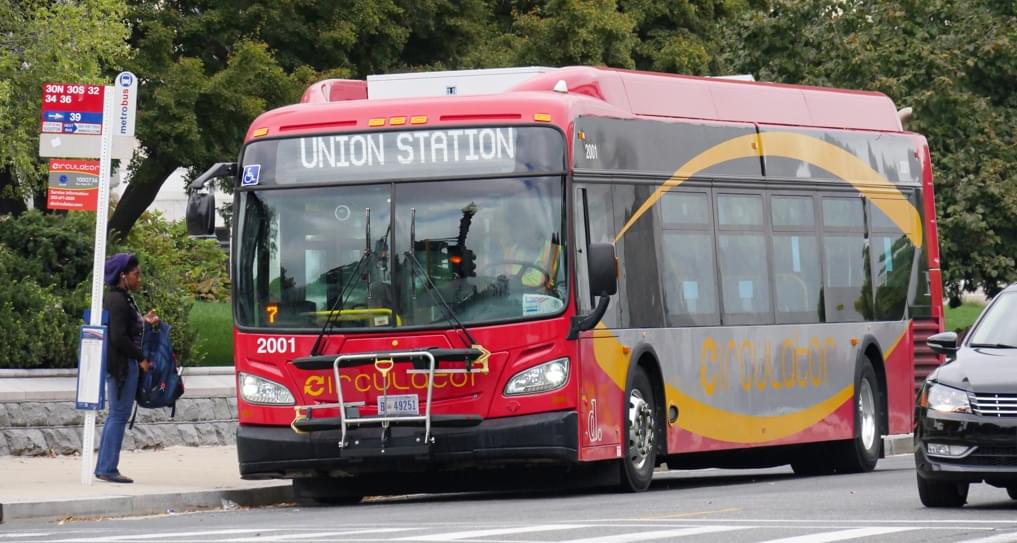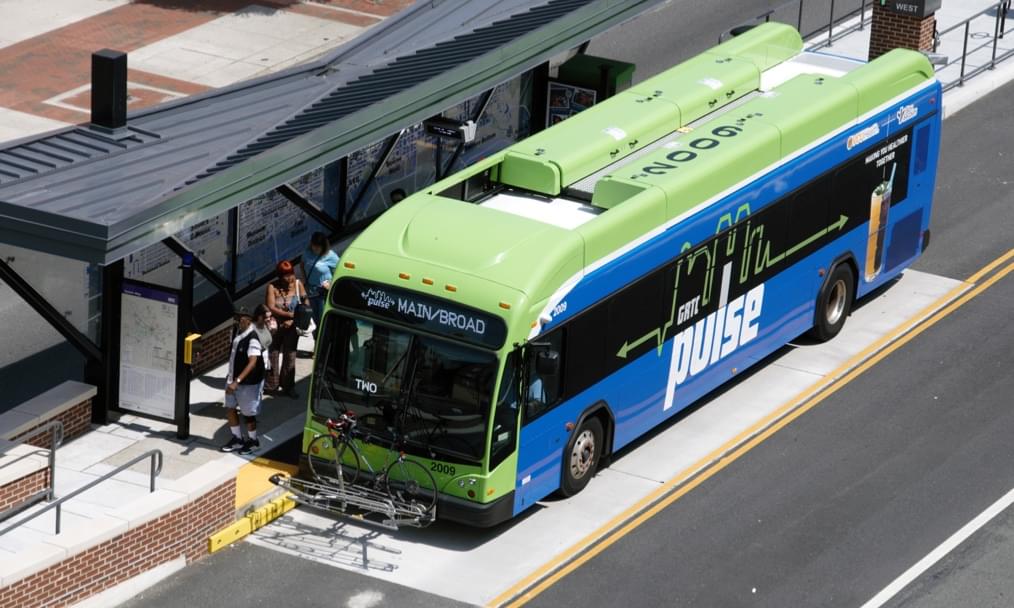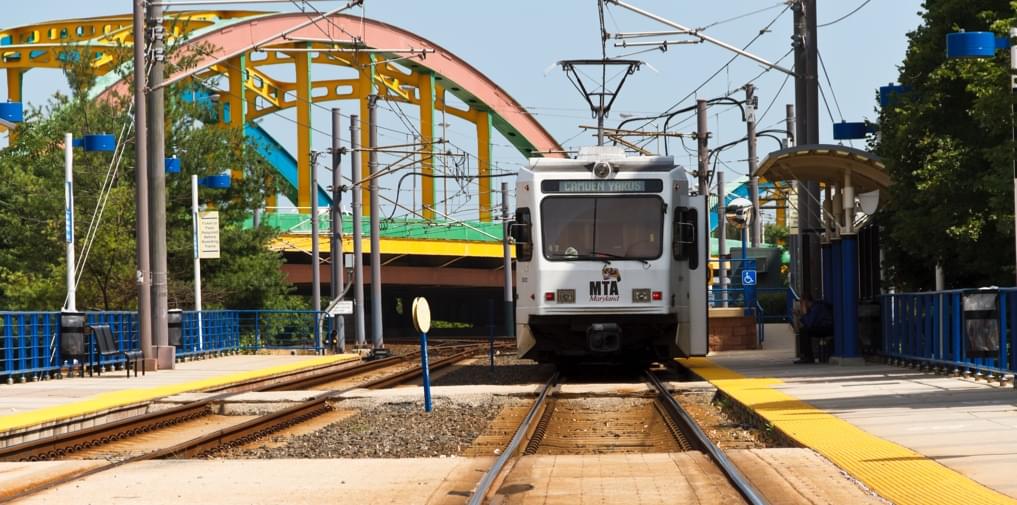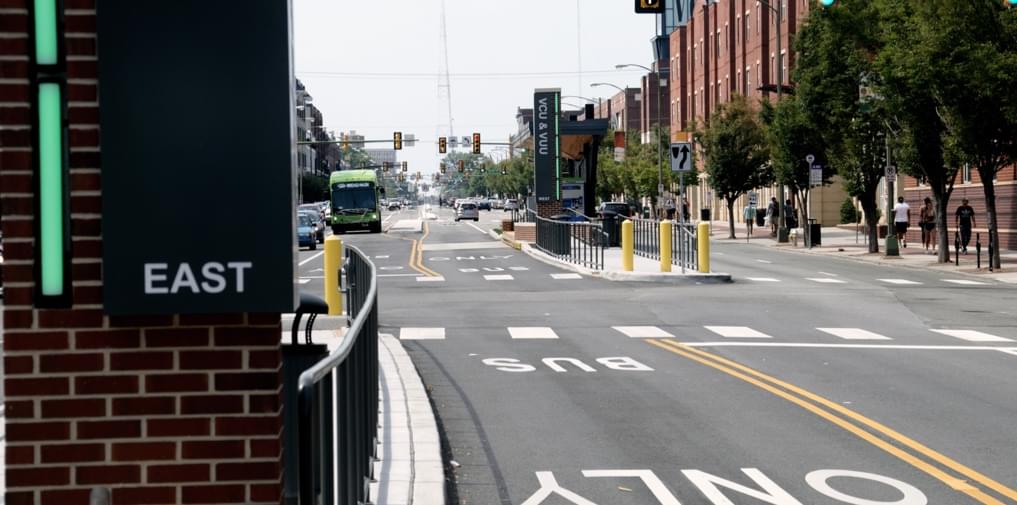Action 3.2
Optimize Washington’s Bus Network and Enhance Coordination of the Metro Area’s Public Transportation Options

What
While Metrorail has been the primary transit focus of policy makers in recent years, bus service in the Washington area also needs improvements to better meet travel demand and ensure fast, reliable trips. For buses to compete with other mobility options in the future, local jurisdictions must improve bus speed and reliability by using dedicated lanes and signal priority on high-ridership, congested corridors.
In total, the Washington metro area has 18 transit operators,1 providing the region many different public transportation options—as well as bikeshare, carshare, and rideshare—to complete a trip. However, these services are not well coordinated, and operations are not standardized — creating unnecessary barriers to improvement and innovation.
A coordinating body that facilitates consultation and agreement between these various transportation agencies would allow the region to better integrate services, rationalize fares, conduct coordinated planning, share facilities, and offer one-stop shopping for customer information.
Why
In 2018, Maryland, Virginia, and the District agreed to provide an additional $500 million in annual dedicated funding to address the Washington Metropolitan Area Transportation Authority’s (WMATA) capital funding shortfall. This historic action will ensure a strong start in fixing many of the maintenance and safety issues that have plagued the Metrorail system in recent years. Attention must now turn to improving the Washington metro area’s bus systems, which provide 600,000 trips each weekday,2 as well as creating the governance structure needed to deliver the seamless, efficient public transportation system the Washington metro area requires.
Bus trips in the Washington area take longer than they used to in the past; as traffic congestion has increased, average Metrobus speeds have dropped 6.5 percent since 2010.3 On average, about one in five buses is more than two minutes early or seven minutes late in serving its stops.4 Slow, unreliable service is not competitive with other trip options (which have multiplied in the region). Since 2010, bus ridership across all transit providers in the Washington metro area has dropped 8 percent.5
Unlike Richmond and Baltimore, the Washington metro area has never had a comprehensive bus system re-design or strategy. Many bus routes are decades old and, while some continue to have high ridership, others may need to be adjusted to serve today’s needs. County- and city-provided bus services have grown tremendously in the past few decades, but parts of the region still remain underserved. A comprehensive, regionwide effort to optimize bus routes, schedules, and marketing to better match demand could improve travel for current bus riders and attract additional riders without significantly increasing costs.
WMATA has initiated a regionwide strategy to deploy faster service on 24 high-ridership corridors, known as the Priority Corridor Network (PCN). County transit agencies are exploring similar services on some of their high-demand routes. However, implementation has been slow, due in part to the fact that the Washington area’s roads have many different owners—each with its own policies regarding transit signal priority, bus-on-shoulder, dedicated bus lanes, and other bus priority treatments. A strategy that spans the entire Washington metro area would create a clear understanding of when such treatments are warranted (for example, through adoption of an MOU on goals or standards for bus service) and the process for implementing them.
With 18 transit operators, several bikeshare and rideshare companies, and multiple jurisdictions, implementing common policies and technologies has been challenging. For example, SmarTrip cards are accepted on WMATA and local buses, but not on Virginia Railway Express (VRE) or Maryland Area Regional Commuter (MARC) commuter rail. VRE riders can board Fairfax Connector buses for free at a VRE station, but cannot board VRE for free when returning to the station by bus. Importantly, there is no single website that provides fare and transfer information for all transit services in the area, though WMATA’s and other trip planning websites include some fare information. As WMATA and other local agencies explore mobile trip payment options, the need for a coordinated approach becomes even more important.
Benefits
Other regions have successfully used tools such as bus route redesigns and bus priority treatments to turn their transit systems around. For example, Seattle used a combination of dedicated bus lanes, priority movement for buses at key intersections, higher frequency on the most popular routes, and faster fare payment to make its buses faster, more reliable, more accessible, and easier to use. As a result, Seattle’s bus ridership has continued to grow—up 16 percent since 20106—while most other bus systems are shedding riders.
International peers are far ahead of U.S. transit agencies when it comes to regional coordination. Eighty-five percent of all Germans and 100 percent of all Austrians are served by regional public transportation associations (called Verkehrsverbund), which integrate services, fares, and ticketing for all public transportation options—bus, subway, and commuter rail—in that region.7 The associations also coordinate public transport planning, schedules, marketing, and customer information.
By working together, the various public transportation agencies across a region can offer higher-quality service and attractive fares, which have resulted in growing ridership and declining use of private vehicles. In Hamburg—a metro area with roughly the same population served as WMATA—the public transportation association coordinates 29 public transportation operators and has successfully grown ridership across the metro area by 72 percent from 1990 to 2015, to more than 750 million trips annually—nearly twice as many trips as WMATA provided in 2015.8
Barriers
Comprehensive changes to bus routes, schedules, fare policies, road treatments, and regional transit integration take time, commitment, and coordination by multiple parties, including significant public outreach to gain community input about goals and priorities. Such efforts have taken several years in other regions and required consistent political leadership to make the bus route optimization and integration of services a priority—something that has not been present in the Washington metro area thus far. Political leadership will also be required to make a new coordinating body effective.
Next moves
A coordinated, comprehensive optimization of bus service in the Washington area—coupled with targeted roadway treatments such as bus-only lanes and transit signal priority—will generate increased ridership, contribute new fare revenues, and make operations more efficient (which is a priority given the cap on increases in the operating budget attached to the new dedicated funding). Further coordination by a new entity to implement fare policy changes and technological improvements across all public transportation providers in the Washington metro area will help remove existing barriers to public transportation use and give consumers a seamless array of mobility options.
The next moves are:
- The region’s transit providers—Metropolitan Washington Council of Governments (MWCOG), Maryland Department of Transportation (MDOT), District Department of Transportation (DDOT), Virginia Department of Rail & Public Transportation (DRPT), and Northern Virginia Transportation Commission (NVTC) should establish a new Public Transportation Coordinating Committee with responsibility for coordinating and standardizing fare policies, schedules, marketing, new technology integration, customer information, and planning across all public transportation systems in the Washington metro area
- WMATA should coordinate with local jurisdictions and MDOT, DDOT, and VDOT to harmonize bus service across all providers in the Washington metro area
- Local jurisdictions, MDOT, DDOT, VDOT, WMATA and other transit providers should establish regional policies for bus priority treatments
- County and city governments should quickly complete ready-to-go bus improvement projects, such as the District’s 16th Street and Downtown West bus priority projects and Montgomery County’s Bus Rapid Transit project on US 29
Costs
Other regions that have implemented a comprehensive bus redesign have been able to do so without significant impact to their operating budgets. Similarly, establishing a new coordinating body should be within most agencies’ existing budget capacity. As these actions can be expected to increase ridership, the additional fare revenue they generate will help offset their modest budgetary impact.
Citations:
- Includes all agencies providing service in the Washington MSA that reported to the National Transit Database in 2016. Of these, 14 provided more than 500,000 annual trips.
- National Transit Database, 2016.
- Ibid.
- Ibid.
- “TransitCenter’s NTD Transit Ridership Analysis, 2002-2017,” TransitCenter, May 2018. https://transitcenter.org/2018/05/01/transitcenters-ntd-transit-ridership-analysis-2002-2017.
- Ibid.
- Buehler, Ralph, John Pucher, and Oliver Dümmler. “Verkehrsverbund: The evolution and spread of fully integrated regional public transport in Germany, Austria, and Switzerland.” International Journal of Sustainable Transportation (2018). https://www.tandfonline.com/doi/full/10.1080/15568318.2018.1431821?scroll=top&needAccess=true.
- Ibid.
Expand to learn more
Collapse



